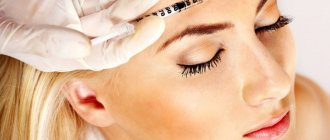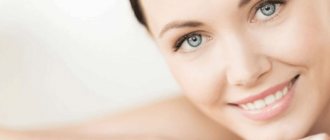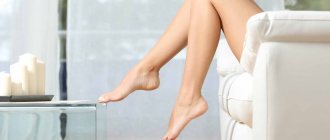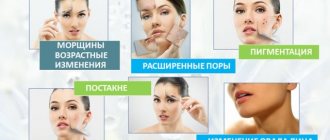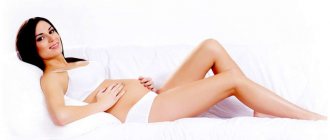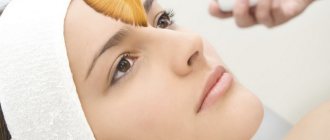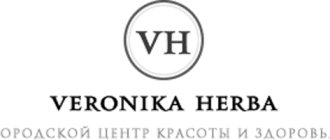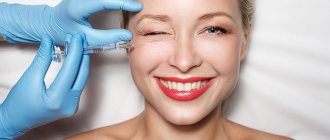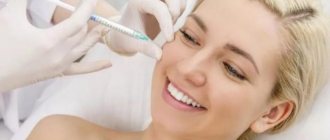Peeling and biorevitalization - when to do what
First, let's define the concepts of “peeling” and “biorevitalization”, which are used in this article.
Peeling is the exfoliation of the skin using chemical acids.
Biorevitalization is the subcutaneous administration of preparations based on hyaluronic acid.
Indications for combined use of these techniques
- Age-related skin changes
- Age over 35 years (earlier administration of hyaluronic acid in a course is not advisable, acid stimulation is sufficient)
- Dry, sagging skin
- Wrinkles, “tired” appearance of the face
- Dark spots
The client must understand that after undergoing 1 procedure, he will probably receive an impressive result, but a short-term one.
Important ! To obtain a lasting result, you must undergo a course of procedures. The number of procedures depends on the age and condition of the skin.
DSA peelings and REPART® biorevitalizants - an effective comprehensive approach to skin rejuvenation
Author: Shai Artem Mikhailovich Ph.D., dermatovenerologist, cosmetologist, anatomist, Moscow
Abstract
Age-related changes in the skin occur in all its layers, therefore, for effective prevention and correction of signs of aging, it is necessary to simultaneously work with both the epidermis and dermis. For this purpose, different methods are combined in cosmetology protocols and programs. One of the most effective combinations is peeling and biorevitalization. This article presents new means for carrying out these procedures, distinguished by the originality of their composition and action.
Keywords
skin, peeling, DSA, biorevitalization, REPART®, ammonium trichloroacetate, hyaluronic acid
Briefly about the features of aging of different layers of the skin, associated clinical signs and methods for their correction
Like the entire human body, the skin undergoes a number of significant changes with age. And although its age-related changes are associated with the general aging process, determined genetically, they are also mediated by the aggressive effects of environmental factors, among which the most destructive is UV radiation [1].
Dermal layer
According to a study by Austrian scientists Rosvita Sgonk and Johann Gruber, presented in the journal Gerontology in 2013, with age, the mitochondrial function of fibroblasts is inhibited, which interferes with the normal functioning of these cells, including a decrease in their synthetic activity. As a result, the quality of the dermal matrix deteriorates—the structure and organization of collagen-elastin fibers are disrupted, and the level of hyaluronic acid decreases [2–4].
Clinical signs of such changes will be sagging (atony), loss of elasticity, deep wrinkles, sagging (ptosis).
The most effective and physiological method of preventing and correcting signs of dermal aging is biorevitalization - intradermal injection of native high-molecular hyaluronic acid (HA). Its mechanism of action is as follows: in the skin, exogenous HA is quickly destroyed into individual small fragments, which serve as signals for fibroblasts to synthesize their own HA. A course of biorevitalization procedures will allow you to reach a level at which the HA content in the dermal layer will correspond to younger skin. This level can then be maintained with periodic procedures.
Epidermis
With age, the rate of epidermal renewal decreases. And this is not only the result of the implementation of the genetic program, but also a consequence of the deterioration of microcirculation. The epidermis has no blood vessels and receives its nutrition from the dermal layer. If the timely supply of nutrients, regulatory and other substances is disrupted, then basal keratinocytes find themselves in conditions of deficiency of the substrate necessary for normal functioning, and their vital activity is inhibited.
Clinical signs of disturbances in the process of renewal and keratinization of the epidermis are numerous fine wrinkles, dull and uneven skin tone, rough rough texture - all these are characteristic signs of age-related changes, reflecting structural changes at the level of the epidermis [5]. There is one more feature: when the rate of division and migration of keratinocytes slows down, the epithelization of the skin worsens, and this must be remembered when using chemical peels [6, 7].
Chemical peeling is considered the most effective and safe way to exfoliate and activate the rate of epidermal renewal. There is a wide variety of peeling preparations on the market, differing in mechanism and depth of action. All of them, with the exception of retinol peeling, somehow damage the stratum corneum and barrier structures of the skin upon contact with the skin. This damage triggers the activation of mitosis of basal keratinocytes and their migration to repair the damage.
Work on finding new substances and improving formulations for topical and injection effects on the skin does not stop, and interesting products appear on the market every year. We present two such new products - DSA Deep Skin Art peelings and REPART® biorevitalizants, developed by Russian specialists on their own scientific and technical base.
DSA Deep Skin Art peelings based on ammonium trichloroacetate
Trichloroacetic acid (TCA) has a long history of use in dermatological practice as a peeling agent. Its action is to break the disulfide bonds of proteins that it encounters on its way. In the stratum corneum these are protein corneodesmosomes, keratin and proteolytic enzymes, in the living layers of the skin - protein receptors on cell membranes, extracellular proteins and enzymes. TCA is highly toxic and irreversibly damages proteins. It easily penetrates the stratum corneum, can reach the dermis and even enter the bloodstream. And although there are ways to control its penetration (this is the appearance of a frost consisting of coagulated proteins, or a special color indicator added to the compositions), the TCA peel procedure remains risky, painful and requires a long recovery period. Patients had to take risks and endure the severe pain that occurs when TCA gets into the skin. Before the era of injection cosmetology and the advent of new hardware technologies, there were essentially no other ways to reach the deep layers of the skin in order to initiate structural changes in them. Today we have excellent effective and safe alternatives, so classic TCA peeling has become less and less used.
However, it turned out to be too early to erase TCA from the arsenal of cosmetological methods. This substance has returned, but in a modified form. Several years ago, a drug appeared on the market in which TCA was not present in a free state, but in combination with urea peroxide. As part of such a complex, TCA is neutralized and does not destroy proteins. The complex is relatively stable, and its breakdown releases TCA, urea and peroxide, which quickly decomposes to water and oxygen. Most of the complexes disintegrate in the dermal layer, where the following occurs: TCA nonselectively denatures protein structures, incl. “old” fibers, making them available for destruction by metalloproteinases and subsequent replacement by new fibers, and oxygen intensifies cellular respiration and synthetic activity of fibroblasts.
| Table. 1. Composition, indications, clinical results and recommendations for the use of DSA Deep Skin Art peelings | |
Peeling DSA pH 2.3Active Ingredients
| Peeling DSA black pH 2.3Active Ingredients
|
Indications:
| Indications
|
Action
| Action
|
Well: 4–6 procedures, once every 7–10 days Procedure time: 45 min (including mask exposure) Bottle volume: 5 ml 1 bottle is designed for at least 2 procedures. Drug consumption:
| |
This interesting technology has been further developed in the peelings of the DSA Deep Skin Art line, which include a complex of ammonium salt TCA (ammonium trichloroacetate) with peroxide. This complex is more stable and, compared to the TCA/urea peroxide complex, does not hydrolyze as quickly, which, on the one hand, increases safety due to the slower release of TCA, and on the other, prolongs the action of the substance in the skin.
DSA Deep Skin Art peelings contain kojic acid (5%) - it reduces the production of melanin and significantly lightens age spots and prevents the appearance of new ones. DSA black peeling also contains black activated bamboo charcoal, which has absorbent and bactericidal properties. It is able to draw out and absorb microparticles of pollution, excess sebum, microorganisms and metabolic products from the surface of the skin (Table 1).
Essentially, by using a modified TCA peel, we induce chemical remodeling of the dermis without trauma. A small part of TCA, which was released earlier in the epidermis, is enough to stimulate the division and migration of keratinocytes of the basal layer. Therefore, a few days after the procedure, slight peeling may be observed, which can be easily corrected with a moisturizer. Immediately after the procedure, the patient will notice an increase in turgor, straightening of fine wrinkles and a slight blush that gives freshness. This is due to the reaction of skin vessels - they expand, providing blood flow to the treatment site. This effect can last for several days and is very popular with patients.
Thus, DSA Deep Skin Art peels managed to preserve the beneficial properties of TCA and minimize risks and injuries. These peels do not require a recovery period, and procedures can be performed year-round. They can be recommended as an express “get out” procedure, and in addition, they are ideal for preparing the skin for aggressive aesthetic procedures, prolonging and enhancing the effect of injection and hardware procedures.
Biorevitalizants REPART®
The REPART® product line (Table 2) are biorevitalizant gels for intradermal administration based on the sodium salt of native high-molecular hyaluronic acid of biotechnological origin. Pharmaceutical quality raw materials are used for their production, production complies with EU GMP standards.
The remodeling effect of biorevitalizants is associated with the signaling effect of HA fragments formed as a result of enzymatic biodegradation of high molecular weight HA on fibroblasts. In response, fibroblasts begin to synthesize their own HA, as a result the turgor of the skin tissue increases, the skin tightens, and wrinkles are smoothed out.
Repart ® 4 Aqua Balance: the concentration of sodium hyaluronate is close to the physiological one, characteristic of the intercellular substance of the dermis, which promotes uniform distribution of the drug in the tissue and rapid achievement of the effect, as well as a reduction in the rehabilitation period associated with contouring of papules. This is due to the combination of two fractions of HA of different molecular weights: HA 1.2 million Da provides an instant effect of radiance and plumpness of the skin; HA 2.5 million Da promotes prolonged biorevitalization. The clinical results of using the drug are: increasing the hydro reserve and hydration of the dermis and, as a result, smoothing wrinkles, increasing elasticity, tone and improving skin color. The target patients for the use of this drug are young and middle-aged patients who need preventive and corrective anti-aging measures.
Repart ® 5 Active: the concentration of sodium hyaluronate is selected to create a lifting and firming effect on the skin. Provides reliable results in smoothing fine and medium-deep wrinkles and reduces skin flaps. Indicated for middle-aged and elderly patients with manifestations of dermatoatrophy, severe and persistent dryness, with thin skin and a finely wrinkled morphotype.
Repart ® 6 Delicate: the concentration of hyaluronate is within the optimal physiological range. This allows the drug to be instantly distributed in the tissues and not be contoured in the form of tubercles. Provides rapid hydration and improvement of skin color, helps prevent age-related changes in the dermis caused by both chronological processes and those provoked by external factors. Indicated for young patients, when working with delicate areas, patients with a deformational morphotype and those prone to edema.
Repart ® 7 Ultimate: the product has a denser texture. This is due to the combination of hyaluronic acid and mannitol. Thanks to mannitol, the moisture-holding properties of the drug are increased and the time of biofermentation of hyaluronic acid in the dermis is slowed down, which ultimately provides a prolonged effect of moisturizing and revitalizing the skin. Mannitol also has antioxidant and anti-inflammatory effects, which increases the effectiveness of the drug against the manifestations of premature aging. The clinical results of using this product are: pronounced hydration, increased skin turgor and density. Indicated for patients of middle and older age groups, with finely wrinkled type, with severe dryness, for skin bioreinforcement procedures.
| Table 2. REPART® line of biorevitalizants | ||||
| Repart® 4 Aqua balance | Repart® 5 Active | Repart® 6 Delicate | Repart® 7 Ultimate | |
| HA concentration, % | 1,0 | 1,8 | 0,5 | 1,35 |
| Additional components | — | — | — | Mannitol, 9 mg/ml |
| Molecular weight of HA, million Da | 1.2 and 2.5 | 1,2 and 3 | 1,2 | 1,2 |
| Well | 10–14 days. Maintenance procedures: once every 1.5–2 months | 3–6 procedures, after 2 weeks. Maintenance procedures: once every 1.5–2 months | 4–6 procedures, every 7–10 days. Maintenance procedures: once every 1.5–2 months | 3 procedures after 2 weeks, then after 2 months. Maintenance procedures: once every 3–4 months |
Combined skin rejuvenation procedure using DSA peeling and REPART® biorevitalizant
Peeling activates the metabolic activity of cells and starts repair processes, but in order for them to be successful, the skin must have good regenerative potential. For this purpose, biorevitalization of the skin is carried out.
As an example, we give an algorithm for a combined procedure developed by specialists.
Indications
- Pronounced manifestations of skin aging caused by age-related atrophy.
- Dull, uneven skin tone.
- Dehydrated skin with reduced turgor and sagging.
- Hyperkeratosis.
- Signs of photoaging.
- Finely wrinkled type of aging.
Protocol
- Cleanse the skin of the target areas with DSA Deep Skin Art foam and treat with an aqueous antiseptic solution.
- Apply anesthetic cream for 20 minutes.
- Carry out the biorevitalization procedure with one of the products from the Repart ® line. Recommended techniques: papular, tubercular, linear.
- After capillary bleeding stops, dry the skin.
- Apply 1-2 layers of DSA peeling (2-2.5 ml). Erythema may appear or worsen for a short time.
- Rub in the peeling until the slip stops.
- Remove peeling with wipes soaked in an aqueous antiseptic solution.
- Apply DSA Deep Skin Art oxygen gel mask for 15–20 minutes. Absorb the remaining mask into the skin.
- Apply a soothing and moisturizing product.
- Apply a photoprotective agent.
Literature
- Hertel B. Molecular and cellular mechanisms of natural aging and photoaging (stress factors, protective mechanisms). Cosmetics and medicine. 2000; 4:5–17.
- Bonifant H., Holloway S. A review of the effects of aging on skin integrity and wound healing. Br J Com Nurs 2019; 24(Suppl. 3): 28–33.
- Sgonc R., Gruber J. Age-related aspects of cutaneous wound healing: a mini-review. Gerontology 2013; 59(2):159–164.
- Sparavigna A., Tenconi B., De Ponti I. Antiaging, photoprotective, and brightening activity in biorevitalization: a new solution for aging skin. Clin Cosmet Investig Dermatol 2015; 8:57–65.
- Guo S., DiPietro LA Critical review in oral biology and medicine: factors affecting wound healing. J Dental Re 2010; 89(3): 219–229.
- Holt DR, Kirk SJ, Regan MC, Hurson M., Lindblad WJ, Barbul A. Effect of age on wound healing in healthy human beings. Surgery 1992; 112(2): 293–297.
- Truchuelo M., Cerda P., Fernández LF Chemical Peeling: A Useful Tool in the Office. Actas Dermosifiliogr 2017; 108(4): 315–322.
READ ARTICLE
Results of combined application of techniques
By alternating biorevitalization and peelings in the shortest possible time (compared to monotherapy), you can achieve:
- Eliminate dryness and flaking of the skin;
- Increasing skin density, smoothness and elasticity;
- Elimination of wrinkles and age spots;
- Improves facial skin color and tone.
These results are achieved by removing dead epidermal cells, improving cellular respiration, creating a favorable environment for fibroblasts and stimulating them to produce new collagen fibers.
General characteristics of the drug Biorepil
BioRePeelCl3 (Biorepil peeling) is often called a means for biorevitalization without injections. After the first procedure, a noticeable lifting effect, increased skin tone, and smoothing of fine wrinkles are observed. This is an innovative peeling with patented technology. Thanks to its balanced composition, the drug guarantees high efficiency from its use. You cannot buy BioRePeel peeling - the product is not on the market and is purchased only by cosmetology clinics.
The peeling contains the following active ingredients:
- moisturizing components arginine and squalane;
- acids (lactobionic, tartaric, gamma-aminobutyric, salicylic, citric);
- isoproline and riboflavin;
- Vit.C, Vit. AT 2;
- sodium ascorbate;
- proline and glycine (amino acids that are components of collagen).
Biorepil is a two-phase product. Immediately before use, the lipophilic and hydrophilic phases are mixed. After application to the skin, they begin to work, multiplying the effect of each other. The active components of the product penetrate deep into the dermis, nourishing, moisturizing and restoring it.
The effect of this product is expressed in gentle exfoliation. In addition, it stimulates the basal layer of the epidermis, due to which a noticeable lifting effect appears, the skin texture is evened out, and pigmentation practically disappears.
Options for the combined use of peeling and biorevitalization techniques
First birevitalization, then peeling
This is the most common technique , the idea is to first “nourish” and let hyaluronic acid work, then carry out a peeling course on the prepared skin.
This is most important for depleted skin conditions, when the skin’s own resources suffer.
Recommended timing: peeling is performed 2 weeks after biorevitalization .
First peeling, then biorevitalization
A less popular scheme, but relevant for severe hyperkeratosis of the skin, when the primary task is its elimination.
The number of necessary procedures is determined individually by a specialist and depends on the aggressiveness of the peeling. On average, this is 1-2 superficial peeling procedures.
Recommended timing: biorevitalization is carried out 4-5 days after superficial peeling , after medium peeling - 3-4 weeks .
That is, after restoration of the integrity of the skin.
Read about which facial peeling is right for you personally and how to choose it in the article at the link .
Simultaneously
Some experts categorically deny the possibility of combining these techniques into one procedure.
However, in the modern world, modern women rarely have enough time to regularly visit a specialist and exclude the possibility of “stretching out” self-care procedures.
So, is it possible to combine birevitalization and peeling in one procedure? YES!
Provided that the peeling performed is not just superficial, but also atraumatic.
Peeling after biorevitalization
Peeling after biorevitalization is not only useful, but in certain cases it is extremely important. Whether it is needed before hyaluronic acid injections is determined by a cosmetologist. Experts recommend doing biorevitalization first in the following cases:
- if the skin is in poor condition due to bad habits, hypovitaminosis, unfavorable climatic conditions;
- if both procedures are done for the first time (the skin must get used to it);
- if deep or medium cleansing is carried out (hyaluronic acid smoothes the surface of the skin, making the acids act more smoothly);
- if dry cleaning is done (swelling after aggressive drugs is weakened);
- if the aging process is pronounced, pigmentation appears.
If there are no complications after biorevitalization, peeling can be done only after 2 weeks. But the duration of the pause in each specific case is determined by the composition (liquid or ether) of the biorevitalizant. The pause between hyaluronic injections should also be at least 2 weeks.
Which procedure to choose
In the modern beauty industry, it is allowed to combine peeling and biorevitalization procedures. Such a solution not only makes it possible to have a comprehensive effect on the patient’s skin, but also makes it possible to enhance the effect bilaterally.
So after what time it is allowed to do biorevitalization after peeling and what is required to minimize side effects - we will try to figure this out further.
It should be noted that peeling and biorevitalization have differences in terms of the patient’s age. For example, peeling can be carried out even during puberty, when boys and girls experience excessive oily skin, acne and comedones. But biorevitalization is indicated for women aged 30 years and older. The fact is that before this period, girls already produce a sufficient amount of hyaluronic acid. Therefore, additional injection of collagen is absolutely inappropriate.
Is it possible to perform both procedures at the same time? Absolutely not. After all, both effects on the skin are extremely traumatic. After each method used, there must be a rehabilitation period, so doing another within one session is contraindicated, but approaches can be successfully combined.
Features of the procedures:
- a gap must be maintained between sessions so that the skin can recover after aggressive exposure;
- peeling is recommended to be carried out before the biorevitalization procedure, because it will facilitate better penetration of hyaluronate into the deep layers of the epidermis (the reverse sequence is also possible);
- the combination of both methods improves their effectiveness by 1.5–2 times;
- if you plan to carry out a combined effect on the skin, you will need fewer procedures (as a rule, 1-2 peeling sessions and 2-3 biorevitalization sessions are performed), which will allow you to save money and time.
At what intervals after peeling can biorevitalization be done? It all depends on the individual characteristics of the patient. On average, cosmetologists adhere to the norm of 10–14 days after chemical peeling when using strong acids and 3–4 days after retinoic cleansing.
The essence of the procedures
To understand whether peeling is necessary before biorevitalization, it is first advisable to understand the specifics of both procedures.
They are very popular among the fair sex who care about their appearance. Using these techniques, you can effectively rejuvenate and tighten the skin, cleanse it, and make it more hydrated. You will achieve better results if you carry out these procedures regularly. But you should not abuse them, ignoring the recommendations of specialists.
Peeling
During this procedure, no substances are injected under the patient's skin. Peeling improves local metabolism by removing dead cells. After it only the healthy and young remain.
Skin renews itself throughout a person's life. As the epidermis gets older, this process slows down - dead cells are separated much less easily.
Sometimes the “spent” layer remains on the surface for a long time and interferes with the penetration of nutrients and tissue respiration. In order for the skin to function normally, it is necessary to stimulate natural metabolism, removing dead cells in a timely manner.
Acid peeling is one of the most effective procedures. When carrying out such cleaning, special preparations are used. These products are quite concentrated, so they are not recommended for use at home. It is better to entrust acid peeling to an experienced cosmetologist.
Biorevitalization
This procedure involves the introduction of hyaluronic acid into the skin. This substance is part of the skin, blood, lymph, therefore it is absolutely safe. To transport it into the dermis and epidermis, laser devices or injections are used.
Hyaluronic acid takes root remarkably well, is not rejected by the human body and provides the following beneficial effects:
- saturating the skin with elements that are necessary for its normal functioning (minerals, vitamins, etc.);
- improvement of metabolic processes;
- acceleration of elastin and collagen production;
- deep hydration, moisture retention.
To achieve better results, you need a course of such procedures. A professional can determine their number. He will take into account the presence of contraindications and indications, the woman’s age, and the condition of the skin.
Is preparation required for the procedure?
Apart from the mandatory consultation with a cosmetologist, no preparatory measures are required from the patient. However, to get the maximum effect from peeling, it is advisable to follow these recommendations:
- at least 7 days before the procedure, do not sunbathe in the sun or visit a solarium;
- the day before peeling, refrain from using any decorative and skincare cosmetics.
Choosing the right sequence
Peeling or biorevitalization? Experts in the world of cosmetology are confident that you can combine both procedures, expecting a double effect. That is why they recommend not just giving preference to any one effect, but resorting to an integrated approach that involves cleaning pores, improving epidermal regeneration and introducing collagen.
What to do first - peeling or biorevitalization? The answer is obvious - it all depends on the individual characteristics of each organism.
It should be noted that when using aggressive, highly concentrated acids, peeling is first done, and then invasive intervention is used. Yellow (retinoic) peeling is also possible after biorevitalization, but to achieve a positive effect you will need to inject hyaluronic acid several times under the skin.
Peeling before biorevitalization:
- prolongs rejuvenation for up to 1 year;
- will provide a pronounced moisturizing effect;
- will make the oval clear and the skin tightened;
- eliminates scars and age spots;
- will provide additional smoothing of wrinkles.
Interesting point: Retinoic peeling accumulates under the skin 3 days after the procedure, protecting the dermis from the harmful effects of the external environment. But such a positive effect is not endless, so you need to periodically administer vitamin A after the combined course.
After peeling, the patient may experience severe swelling. Hyaluronic acid absorbs all excess moisture, minimizing swelling and speeding up the recovery period.
Some cosmetologists, on the contrary, first do biorevitalization, and then medium or deep chemical cleansing of the face. This sequence is relevant:
- if you have bad habits;
- when a change in climatic conditions is planned;
- the patient has an unbalanced diet;
- serious age-related changes on the face - drooping of the upper eyelid, hyperpigmentation is observed, increased relief and deep expression wrinkles are formed;
- with further laser resurfacing;
- when chemical peeling will be done for the first time (for preparation purposes).
As you can see, the procedures can be swapped depending on the expected effect.
Restrictions
Cosmetologists unanimously declare that peeling and injecting hyaluronic acid in one visit to a cosmetologist is prohibited. To achieve maximum effect, adhere to the following rules:
- protect your dermis with sunscreen and stay in the sun as little as possible;
- minimize physical activity;
- try not to touch your face on the first day in order to reduce the risk of introducing bacteria;
- sauna, facial massage and bath are prohibited in the first 7 days;
- on the first day after the procedures, do not wash your face or use decorative cosmetics;
- For better healing of the dermis, use pharmaceutical ointments prescribed by a cosmetologist.
Thus, given the difference in methods and effects on the epidermis, it is impossible to answer which is better - peeling or biorevitalization. Both techniques are aimed at rejuvenating and stimulating the regeneration of the epidermis.
It is important that, taking into account the characteristics of your body and the problem that has arisen, they are carried out at certain intervals - when the skin recovers from stress after the procedure. Peeling can be carried out both before and after biorevitalization. Weak acid peels (retinoic and almond) can even be combined with the introduction of hyaluronic acid.
Recommendations for skin care after the procedure
In order not to harm the skin and consolidate the effect of peeling, you must adhere to the following recommendations:
- For three days after the procedure, wipe your facial skin exclusively with micellar water;
- After washing, gently blot the skin with a soft towel (or paper napkins);
- refuse to use care and decorative cosmetics;
- after the first three days after peeling, wash your face with boiled warm water;
- treat the areas of skin where peeling was performed with care (protect from mechanical and chemical influences);
- drink at least 1.5 liters of water per day;
- use sunscreen if necessary.
Choose a time that is convenient for you - visit the “Latum Clinic” not far from Dmitrovskoye Highway, near the Yakhromskaya metro station (former metro station “Ul. 800 Letiya Moskvy”). You can sign up for a consultation directly on the website. You can also order a call back - the manager will contact you to discuss all the details. Peeling Biorepil at an affordable price is the best solution for those who care about their beauty!
Effect of peeling Biorepil
The drug has the following effects on the skin:
- biostimulating (fibroblast activity is stimulated);
- keratolytic;
- revitalizing;
- tightening pores;
- antioxidant.
This is manifested by the following changes:
- wrinkles on the skin are smoothed out, its relief is evened out;
- pigmentation disappears;
- pores become less noticeable;
- comedones and acne disappear;
- the skin acquires an even healthy shade, becomes elastic and moisturized;
- noticeable rejuvenation effect from Biorepil peeling after the first sessions.
Benefits of Biorepil peeling
BioRePeel peeling has biostimulating, exfoliating, and revitalizing effects.
The main advantages can be considered:
- requires a minimum amount of time to complete (no more than 20 minutes);
- suitable for any skin type;
- can be performed all year round (all-season peeling);
- the procedure is completely safe and painless, so no anesthesia is required before it is performed;
- absence of ammonia in the composition;
- noticeable results after just one session;
- no redness or swelling of the skin after peeling;
- long-lasting effect;
- the ability to combine Biorepil peeling with other procedures in our clinic (injection, hardware, phototherapy, radio wave therapy).
